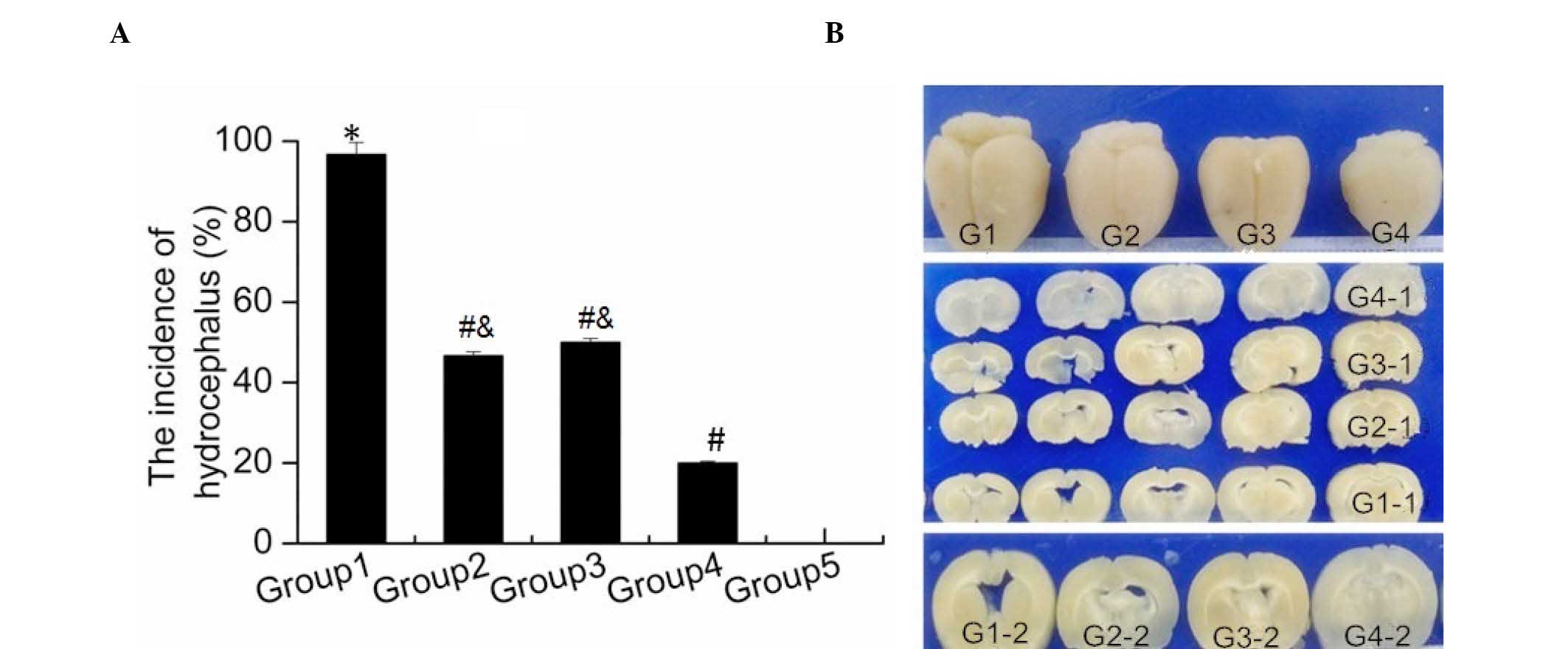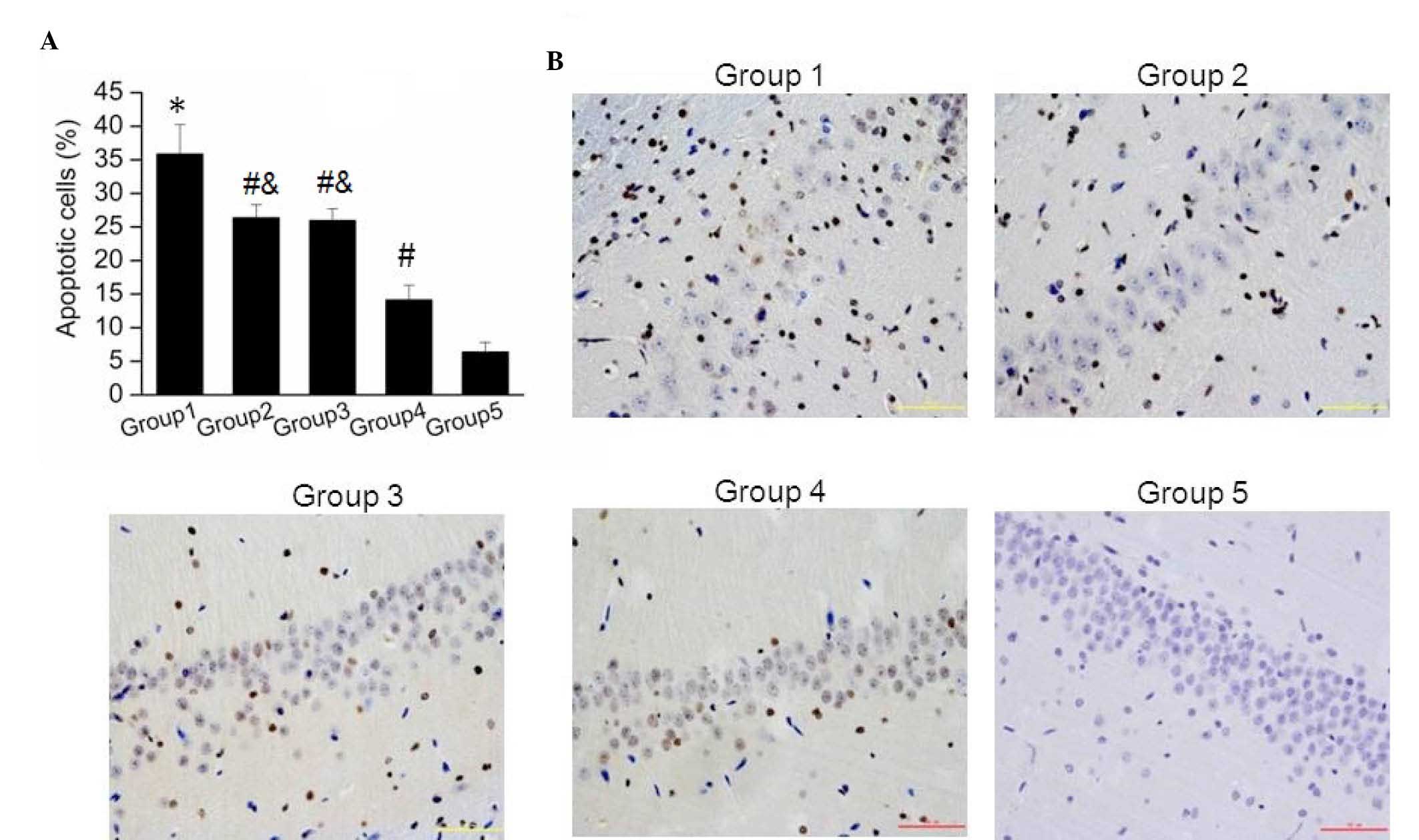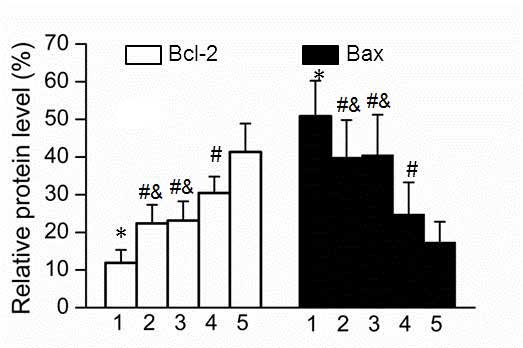|
1
|
Vassilyadi M, Tataryn Z, Shamji MF and
Ventureyra EC: Functional outcomes among premature infants with
intraventricular hemorrhage. Pediatr Neurosurg. 45:247–255. 2009.
View Article : Google Scholar : PubMed/NCBI
|
|
2
|
Cherian SS, Love S, Silver IA, Porter HJ,
Whitelaw AG and Thoresen M: Posthemorrhagic ventricular dilation in
the neonate: Development and characterization of a rat model. J
Neuropathol Exp Neurol. 62:292–303. 2003. View Article : Google Scholar : PubMed/NCBI
|
|
3
|
Zacharia BE, Vaughan KA, Hickman ZL, Bruce
SS, Carpenter AM, Petersen NH, Deiner S, Badjatia N and Connolly ES
Jr: Predictors of long-term shunt-dependent hydrocephalus in
patients with intracerebral hemorrhage requiring emergency
cerebrospinal fluid diversion. Neurosurg Focus. 32:E52012.
View Article : Google Scholar : PubMed/NCBI
|
|
4
|
Simard PF, Tosun C, Melnichenko L, Ivanova
S, Gerzanich V and Simard JM: Inflammation of the choroid plexus
and ependymal layer of the ventricle following intraventricular
hemorrhage. Transl Stroke Res. 2:227–231. 2011. View Article : Google Scholar : PubMed/NCBI
|
|
5
|
Chen FM, Wu LA, Zhang M, Zhang R and Sun
H: Homing of endogenous stem/progenitor cells for in situ tissue
regeneration: Promises, strategies, and translational perspectives.
Biomaterials. 32:3189–3209. 2011. View Article : Google Scholar : PubMed/NCBI
|
|
6
|
Bellenchi GC, Volpicelli F, Piscopo V,
Perrone-Capano C and di Porzio U: Adult neural stem cells: An
endogenous tool to repair brain injury? J Neurochem. 124:159–167.
2013. View Article : Google Scholar : PubMed/NCBI
|
|
7
|
Lindvall O, Kokaia Z and Martinez-Serrano
A: Stem cell therapy for human neurodegenerative disorders-how to
make it work. Nat Med Suppl. S42–S50. 2004. View Article : Google Scholar
|
|
8
|
Yanqing Z, Yu-Min L, Jian Q, Bao-Guo X and
Chuan-Zhen L: Fibronectin and neuroprotective effect of granulocyte
colony-stimulating factor in focal cerebral ischemia. Brain Res.
1098:161–169. 2006. View Article : Google Scholar : PubMed/NCBI
|
|
9
|
Hartung T: Anti-inflammatory effects of
granulocyte colony-stimulating factor. Curr Opin Hematol.
5:221–225. 1998. View Article : Google Scholar : PubMed/NCBI
|
|
10
|
Schäbitz WR, Kollmar R, Schwaninger M,
Juettler E, Bardutzky J, Schölzke MN, Sommer C and Schwab S:
Neuroprotective effect of granulocyte colony-stimulating factor
after focal cerebral ischemia. Stroke. 34:745–751. 2003. View Article : Google Scholar : PubMed/NCBI
|
|
11
|
Chuang DM, Chen RW, Chalecka-Franaszek E,
Ren M, Hashimoto R, Senatorov V, Kanai H, Hough C, Hiroi T and
Leeds P: Neuroprotective effects of lithium in cultured cells and
animal models of diseases. Bipolar Disord. 4:129–136. 2002.
View Article : Google Scholar : PubMed/NCBI
|
|
12
|
Chen RW and Chuang DM: Long term lithium
treatment suppresses p53 and Bax expression but increases Bcl-2
expression. A prominent role in neuroprotection against
excitotoxicity. J Biol Chem. 274:6039–6042. 1999. View Article : Google Scholar : PubMed/NCBI
|
|
13
|
Chen G, Zeng WZ, Yuan PX, Huang LD, Jiang
YM, Zhao ZH and Manji HK: The mood-stabilizing agents lithium and
valproate robustly increase the levels of the neuroprotective
protein bcl-2 in the CNS. J Neurochem. 72:879–882. 1999. View Article : Google Scholar : PubMed/NCBI
|
|
14
|
Katoh M: WNT signaling in stem cell
biology and regenerative medicine. Curr Drug Targets. 9:565–570.
2008. View Article : Google Scholar : PubMed/NCBI
|
|
15
|
Hirsch C, Campano LM, Wöhrle S and Hecht
A: Canonical Wnt signaling transiently stimulates proliferation and
enhances neurogenesis in neonatal neural progenitor cultures. Exp
Cell Res. 313:572–587. 2007. View Article : Google Scholar : PubMed/NCBI
|
|
16
|
Chamnanvanakij S, Margraf LR, Burns D and
Perlman JM: Apoptosis and white matter injury in preterm infants.
Pediatr Dev Pathol. 5:184–189. 2002. View Article : Google Scholar : PubMed/NCBI
|
|
17
|
Di Renzo GC, Mignosa M, Gerli S, Burnelli
L, Luzi G, Clerici G, Taddei F, Marinelli D, Bragetti P, Mezzetti
D, et al: The combined maternal administration of magnesium sulfate
and aminophylline reduces intraventricular hemorrhage in very
preterm neonates. Am J Obstet Gynecol. 192:433–438. 2005.
View Article : Google Scholar : PubMed/NCBI
|
|
18
|
Chemtob S, Laudignon N and Aranda JV: Drug
therapy in hypoxic-ischemic cerebral insults and intraventricular
hemorrhage of the newborn. Clin Perinatol. 14:817–842.
1987.PubMed/NCBI
|
|
19
|
Vose LR, Vinukonda G, Jo S, Miry O,
Diamond D, Korumilli R, Arshad A, Zia MT, Hu F, Kayton RJ, et al:
Treatment with thyroxine restores myelination and clinical recovery
after intraventricular hemorrhage. J Neurosci. 33:17232–17246.
2013. View Article : Google Scholar : PubMed/NCBI
|
|
20
|
Ahn SY, Chang YS, Sung DK, Sung SI, Yoo
HS, Lee JH, Oh WI and Park WS: Mesenchymal stem cells prevent
hydrocephalus after severe intraventricular hemorrhage. Stroke.
44:497–504. 2013. View Article : Google Scholar : PubMed/NCBI
|
|
21
|
Lodhia KR, Shakui P and Keep RF:
Hydrocephalus in a rat model of intraventricular hemorrhage. Acta
Neurochir Suppl. 96:207–211. 2006. View Article : Google Scholar : PubMed/NCBI
|
|
22
|
Paczkowska E, Dabkowska E, Nowacki P and
Machaliński B: Stem cell-based therapy in central nervous system
diseases. Neurol Neurochir Pol. 43:550–558. 2009.(In Polish).
PubMed/NCBI
|
|
23
|
Rodríguez EM, Guerra MM, Vío K, González
C, Ortloff A, Bátiz LF, Rodríguez S, Jara MC, Muñoz RI, Ortega E,
et al: A cell junction pathology of neural stem cells leads to
abnormal neurogenesis and hydrocephalus. Biol Res. 45:231–242.
2012. View Article : Google Scholar : PubMed/NCBI
|
|
24
|
Urdzíková L, Jendelová P, Glogarová K,
Burian M, Hájek M and Syková E: Transplantation of bone marrow stem
cells as well as mobilization by granulocyte-colony stimulating
factor promotes recovery after spinal cord injury in rats. J
Neurotrauma. 23:1379–1391. 2006. View Article : Google Scholar : PubMed/NCBI
|
|
25
|
Stumm RK, Rummel J, Junker V, Culmsee C,
Pfeiffer M, Krieglstein J, Höllt V and Schulz S: A dual role for
the SDF-1/CXCR4 chemokine receptor system in adult brain:
isoform-selective regulation of SDF-1 expression modulates
CXCR4-dependent neuronal plasticity and cerebral leukocyte
recruitment after focal ischemia. J Neurosci. 22:5865–5878.
2002.PubMed/NCBI
|
|
26
|
Rath D, Chatterjee M, Borst O, Müller K,
Langer H, Mack AF, Schwab M, Winter S, Gawaz M and Geisler T:
Platelet surface expression of stromal cell-derived factor-1
receptors CXCR4 and CXCR7 is associated with clinical outcomes in
patients with coronary artery disease. J Thromb Haemost.
13:719–728. 2015. View Article : Google Scholar : PubMed/NCBI
|
|
27
|
Blum A, Childs RW, Smith A, Patibandla S,
Zalos G, Samsel L, McCoy JP, Calandra G, Csako G and Cannon RO III:
Targeted antagonism of CXCR4 mobilizes progenitor cells under
investigation for cardiovascular disease. Cytotherapy.
11:1016–1019. 2009. View Article : Google Scholar : PubMed/NCBI
|
|
28
|
Shyu WC, Lin SZ, Yang HI, Tzeng YS, Pang
CY, Yen PS and Li H: Functional recovery of stroke rats induced by
granulocyte colony-stimulating factor-stimulated stem cells.
Circulation. 110:1847–1854. 2004. View Article : Google Scholar : PubMed/NCBI
|
|
29
|
Yata K, Matchett GA, Tsubokawa T, Tang J,
Kanamaru K and Zhang JH: Granulocyte-colony stimulating factor
inhibits apoptotic neuron loss after neonatal hypoxia-ischemia in
rats. Brain Res. 1145:227–238. 2007. View Article : Google Scholar : PubMed/NCBI
|
|
30
|
Roberts AW: G-CSF: A key regulator of
neutrophil production, but that's not all! Growth Factors.
23:33–41. 2005. View Article : Google Scholar : PubMed/NCBI
|
|
31
|
Kawabe J, Koda M, Hashimoto M, Fujiyoshi
T, Furuya T, Endo T, Okawa A and Yamazaki M: Neuroprotective
effects of granulocyte colony-stimulating factor and relationship
to promotion of angiogenesis after spinal cord injury in rats:
Laboratory investigation. J Neurosurg Spine. 15:414–421. 2011.
View Article : Google Scholar : PubMed/NCBI
|
|
32
|
Shen ZJ, Esnault S, Schinzel A, Borner C
and Malter JS: The peptidyl-prolyl isomerase Pin1 facilitates
cytokine-induced survival of eosinophils by suppressing Bax
activation. Nat Immunol. 10:257–265. 2009. View Article : Google Scholar : PubMed/NCBI
|
|
33
|
Garcia AD, Doan NB, Imura T, Bush TG and
Sofroniew MV: GFAP-expressing progenitors are the principal source
of constitutive neurogenesis in adult mouse forebrain. Nat
Neurosci. 7:1233–1241. 2004. View
Article : Google Scholar : PubMed/NCBI
|














